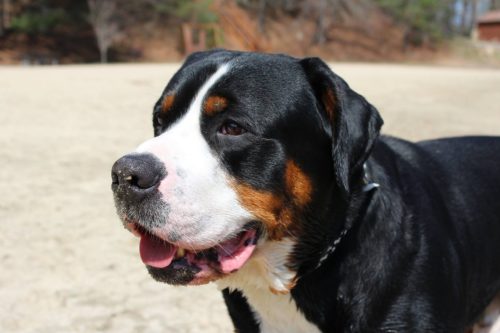Dogs can itch and scratch for a wide variety of reasons. Commonly, allergies are the suspected culprit. However, sometimes your dog’s natural bacterium and flora is to blame, such as what can happen when yeast begins to over populate.
Yeast is a fungus that is a natural part of a dog’s body living in both the gut and on the skin. It functions as one aspect of a healthy and balanced immune system. However, when a dog’s immune system becomes stressed and compromised, yeast growth can become out of control. This causes a reaction in your dog as your dog tries to rid himself of the overgrowth and bring yeast levels back down to normal. When this happens, your dog develops what’s called a yeast infection.
Yeast infections in dogs tend to develop in a hot and humid environment, and can cause irritation in areas that are moist and dark. Areas like this are where the yeast fungi thrive best. The most common type of yeast infection is yeast dermatitis, which affects a dog’s skin, but there are also some organisms that can get inside the blood stream and circulation, and cause more serious health problems. Fortunately, this type of yeast infection is not nearly as common as yeast dermatitis in dogs.
Causes of Yeast Infection in Dogs

The exact trigger that causes yeast to proliferate and grow out of control is not fully known. However, there are several factors that are thought to contribute to yeast infections.
These include things such as:
- Food allergies
- Flea allergies
- Environmental allergies
- Cancer
- A poor diet with nutritional deficiencies
- Prolonged exposure to heat and humidity
- Prolonged usage of drugs and medications, especially antibiotics and steroids well as chemo drugs
- Metabolic diseases and endocrine disorders such Cushing’s disease, Addison’s disease, hypothyroidism, and diabetes mellitus
- Skin parasites can be an issue
- And bacterial skin infections in dogs can grow right alongside a yeast infection
Additionally, dog breeds with lots of folds and wrinkles in their skin have a lot of tender places for yeast to hide, making them more susceptible to an infection as well.
Signs of Yeast Infection in Dogs
Symptoms can run the gamut when it comes to a canine yeast infection. Some of the symptoms include things like skin inflammation and irritation, as well as severe itching in dogs. This is especially true for tender and susceptible areas. Your dog may chew, bite, lick, and rub at the skin and affected area.
Sometimes a dog may suffer from scaly skin due to yeast infection. Elephant skin is also common, which is where your dog develops patches of skin that look dark and thickened.
The areas that appear to be the most prone to infection include:
- In between your dog’s paws
- In his nasal folds
- In and around your dog’s ears
- Around the anal area
- Along his armpits
- As well as around his neck
When an infection is in full swing, your dog may experience:
- Sores
- Redness and irritation
- A sticky and abnormal discharge
Dogs can also experience hair loss and suffer from a greasy-looking coat, as well as a foul stench to the skin that is quite noticeable. If your dog develops a yeast infection in his ears, you will definitely be able to smell it. You also may see a green to yellowish discharge.
Additionally, some dogs can also experience behavioral issues that are associated with extreme itching and pain.
These include:
Preventing Yeast Infection in Dogs
Activities that can contribute to yeast infections are things like swimming, especially in hot and humid areas. Your dog can stay moist for a long time after swimming, and this provides the perfect environment for a yeast overgrowth.
Too much running can also contribute to yeast infections, as moisture can get trapped in between your dog’s toes from sweat, and yeast just loves to grow there.
If you live in hot or humid climates, and any of the above activities are a regular part of your dog’s life, to avoid yeast dermatitis, you might consider making sure your dog gets a weekly bath, so that these areas are washed clean and dried properly.
Risk Factors of Yeast Infection in Dogs
Though yeast infections can be a problem in any dog of any age and breed, as well as any gender, there are certain breeds that appear to be more susceptible, either due to genetic factors, or due to physical characteristics that make a good environment for yeast to make their home.
Breeds that appear to be at risk the most for yeast infections are:
- Basset Hound
- Cocker Spaniel
- Poodle
- German Shepherd
- West Highland White Terrier
- Pug
- Bulldog
- Shar Pei
- Shih Tzu
- Dachshund
Other breeds related to the spaniel family and the hound dog family may also be at risk, due to their long floppy ears.
Diagnosing Yeast Infection in Dogs
Diagnosing a yeast infection definitively can be harder than one might imagine. More often than not, a dog will present with a history of extreme itching, coupled with resulting behaviors such as licking, biting, and chewing the areas that are affected.
Your vet will perform a physical exam to inspect your dog’s skin for areas that may look red, irritated, flaking, crusty, greasy, or smelly. A dog with a yeast infection will almost always have a problem in his ears, which can be an easy way to determine whether further testing may be needed. A dog’s ears with a yeast infection will smell musty, with a distinctive odor. They may also emit a yellowish green discharge.
Your vet will inspect your dog for areas where he may have lost his hair, and they will take a complete oral history of your dog’s health and lifestyle in general. They will want to know whether or not your dog has been vaccinated, whether your dog is on any preventive medications, and whether you travel or if your dog has been exposed to other animals, either domestic or wild.
They will most likely order blood and urine samples as well, to see if your dog has any underlying health issues that may make them vulnerable to a yeast infection. However, these tests won’t diagnose the actual yeast infection.
To diagnose the yeast infection itself, your vet may decide to take skin samples to observe beneath a microscope. This is called cytology, and using this diagnostic measure, your vet can look for the presence of yeast as well as other fungi, mites, bacterium, viruses, and any other organisms that could be causing your dog grief.
In rare cases, your vet may order a skin biopsy to be taken, but those aren’t always useful for diagnosing yeast. Other types of blood testing can also be done, to assess the health of your dog’s endocrine system and to make sure his body is functioning optimally. A healthy body is naturally yeast-resistant.

Treating Yeast Infection in Dogs
Yeast fungi starts proliferating in the gut. So, an initial first step to health, is to evaluate your dog’s diet and nutrition, and assess what he is eating that could be contributing to yeast overgrowth.
The yeast fungi thrive on sugar, including carbohydrates. So, even though your dog doesn’t eat sugar in the way we might think of sugar (candy, cookies, etc.), if he is eating food that is high in carbohydrates, such as corn and potato-based foods, rice, oats, peas and sweet potatoes, all of these can contribute to a proliferation of the yeast inside your dog’s gut. This will then spread elsewhere.
Ideally, you want to feed your dog food that is low in starch. Other things you can do to keep your dog’s gut healthy is to go easy on antibiotics, as well as avoid overuse of other drugs and toxins that could be taxing to the immune system.
This means that vaccines that your dog doesn’t need are not advised, and you should be careful of pesticides found in preventative medications as well as other drugs and chemicals your dog may be ingesting. You can also give your dog things like prebiotics and probiotics to help support a healthy immune system and healthy gut.
When it comes to yeast dermatitis (a yeast infection of the skin), your vet may have you first try topical treatments. These may include antibiotic and anti-seborrheic medications, and anti-fungal medications.
Sometimes, your dog may need an antibacterial medication as well because bacterial infections can be a secondary problem with yeast infections. You can apply these medications in several different ways.
These include:
- Shampoos
- Dips and solutions
- Lotions
- Creams
- Sprays
- Rinses
- Powders
Topical treatments usually need to be reapplied several times each week, and some of them may need to sit on your dog’s skin for a set period of time. If the infection is very severe, oral anti-fungal drugs could be suggested, especially if your dog is not responding to topical treatments. However, drugs of this type can be hard on the kidneys, so it’s recommended to try the topical treatments first.
If your dog happens to develop a secondary bacterial infection, that could require oral antibiotics as well. Obviously, for any of these treatments and therapies to work, the underlying problem that caused the yeast infection in the first place needs to be addressed. Your dog’s health and well-being, as well as longevity depend on keeping his immune system healthy and keeping his gut flora balanced properly.
Natural Treatments for Yeast Infection in Dogs
Natural treatments for canine yeast infections include ensuring your dog is eating a healthy diet low in starch and low in sugars. This includes additives like high fructose corn syrup. Sometimes, a raw food diet may prove beneficial to dogs that are particularly vulnerable to yeast infections.
Prebiotics and probiotics are necessary to help your dog balance his gut bacteria, and Epson salts can sometimes help with this balance as well. You can try giving your dog a bit of Epson salt mixed with drinking water for a couple of days if you suspect your dog is developing a yeast infection. Just remember, the earlier you do this, the better.

You can also try mixing baking soda in your dog’s drinking water for a few days and see if that helps. Like Epson salt, baking soda can get rid of fungal infections and work to balance out the bacterium in your dog’s stomach. It can also relieve uncomfortable gas symptoms.
If your dog seems prone to frequent yeast infections, or if he already has one and is miserable with itchy, stinky skin, then bathing him regularly might help. Just be careful not to over-bathe him, as this can backfire in some cases, and cause the yeast infection to get worse.
Apple cider vinegar is another known natural remedy, praised for its yeast fighting ability. ASV can be successfully used as a rinse after your dog’s bath, as well as be added to his food or water to ingest internally. Just make sure you get your ACV raw and unfiltered for the most benefits.
Finally, coconut oil can be added to your dog’s diet too. It’s highly useful, and can be rubbed into his skin as well as eaten and ingested. Coconut oil has antiviral, anti-fungal, and antibacterial properties, which makes it an excellent weapon against a stubborn yeast infection.
Prognosis of Yeast Infection in Dogs
With proper care and treatment, your dog can recover from a yeast infection completely. However, sometimes your dog may need treatments periodically to manage fresh outbreaks, especially if your dog is one of the breeds that pose a higher risk of developing yeast infections. And to continue fostering your dog’s good health, partner with your vet and make a pointed effort to see that your dog receives regular wellness care moving forward.





